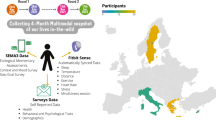Abstract
Longitudinal behavioral data generally contains a significant amount of structure. In this work, we identify the structure inherent in daily behavior with models that can accurately analyze, predict, and cluster multimodal data from individuals and communities within the social network of a population. We represent this behavioral structure by the principal components of the complete behavioral dataset, a set of characteristic vectors we have termed eigenbehaviors. In our model, an individual’s behavior over a specific day can be approximated by a weighted sum of his or her primary eigenbehaviors. When these weights are calculated halfway through a day, they can be used to predict the day’s remaining behaviors with 79% accuracy for our test subjects. Additionally, we demonstrate the potential for this dimensionality reduction technique to infer community affiliations within the subjects’ social network by clustering individuals into a “behavior space” spanned by a set of their aggregate eigenbehaviors. These behavior spaces make it possible to determine the behavioral similarity between both individuals and groups, enabling 96% classification accuracy of community affiliations within the population-level social network. Additionally, the distance between individuals in the behavior space can be used as an estimate for relational ties such as friendship, suggesting strong behavioral homophily amongst the subjects. This approach capitalizes on the large amount of rich data previously captured during the Reality Mining study from mobile phones continuously logging location, proximate phones, and communication of 100 subjects at MIT over the course of 9 months. As wearable sensors continue to generate these types of rich, longitudinal datasets, dimensionality reduction techniques such as eigenbehaviors will play an increasingly important role in behavioral research.












Similar content being viewed by others
References
Addlesee M, Curwen R, Hodges S, Newman J, Steggles P, Ward A, Hopper A (2001) Implementing a sentient computing system. IEEE Computer Magazine 34(8):50–56
Ashbrook D, Starner T (2003) Using GPS to learn significant locations and predict movement across multiple users. Pers Ubiquit Comput 7:275–286
Bar-Noy A, Kessler I (1993) Tracking mobile users in wireless communication networks. IEEE Trans Inf Theory 39(6):1877–1886
Begole, JB, Tang JC, Hill R (2003) Rhythm Modeling, Visualizations, and Applications. Proceedings of the ACM Symposium on User Interface Software and Technology (UIST 2003), ACM: Vancouver Canada, pp 11–20. http://doi.acm.org/10.1145/964696.964698
Bhattacharya A, Das SK (1999) LeZi-update: an information-theoretic approach to track mobile users in PCS networks. In: Proceedings of the International Conference on Mobile Computing and Networking, Seattle, WA
Clarkson B (2002) Life Patterns: structure from wearable sensors. Massachusetts Institute of Technology.
Eagle N, Pentland A (2006) Reality mining: sensing complex social systems. Pers Ubiquit Comput 4:255–268
Fogarty J, Hudson SE, Atkeson CG, Avrahami D, Forlizzi J, Kiesler S, Lee JC, Yang J (2005) Predicting Human Interruptibility with Sensors. ACM Transactions on Computer-Human Interaction (TOCHI) 12(1):119-146, March
Hightower J, Borriello G (2004) Particle Filters for Location Estimation in Ubiquitous Computing: A Case Study. in Proceedings of the Sixth International Conference on Ubiquitous Computing (Ubicomp 2004), (Nigel Davies, Elizabeth Mynatt, and Itiro Siio, eds.), pp. 88-106
Kim SJ, Lee CY (1996) Modeling and analysis of the dynamic location registration and paging in microcellular systems. IEEE Trans Veh Technol 45(1):82–90
Krause J, Lusseau D, James R (2009) Animal social networks: an introduction. Behav Ecol Sociobiol. doi:10.1007/s00265-009-0747-0
Laasonen K, Raento M, Toivonen H (2004) Adaptive On-Device Location Recognition. In: Proceedings for Pervasive, Springer Verlag, pp 287-304
Liao L, Fox D, Kautz H (2004) Learning and Inferring Transportation Routines. In: Proceedings for the National Conference on Artificial Intelligence (AAAI-04), San Jose, CA.
Liben-Nowell D, Novak J, Kumar R, Raghavan P (2005) Geographic routing in social networks. Proc Nat Acad Sci 102(33):11623–11628
Patterson D, Liao L, Fox D, Kautz H (2003) Inferring high-level behavior from low-level sensors. Ubicomp 2003:73–89
Pentland A (1992) Fast solutions to physical equilibrium and interpolation problems. Vis Comput 8(5–6):303–314
Pentland A, Williams J (1989) Good vibrations: modal dynamics for graphics and animation. ACM Computer Graphics 23(4):215–222
Pentland A, Sclaroff S (1991) Closed-form solutions for physically based shape modeling and recognition. IEEE Trans. Pattern Analysis and Machine Intelligence 13(7):715–730
Raento M, Oulasvirta A, Petit R, Toivonen H (2005) ContextPhone—a prototyping platform for context-aware mobile applications. IEEE Pervasive Computing 4(2):51–59
Schilit BN, Adams N, Gold R, Tso MM, Want R (1993) The PARCTAB mobile computing system. In Proceedings of the Fourth Workshop on Workstation Operating Systems, Napa, CA, USA, pp. 34-39. doi:10.1109/WWOS.1993.348175
Turk M, Pentland A (1991) Eigenfaces for recognition. J Cogn Neurosci 3(1):71–86
Want R, Hopper A, Falcao V, Gibbons J (1992) The active badge location system. ACM Trans Inf Sys 10:91–102
Wolf J, Guensler R, Bachman W (2001) Elimination of the travel diary: an experiment to derive trip purpose from GPS travel data. In: Proceedings from the Transportation Research Board 80th annual meeting, Washington, DC.
Author information
Authors and Affiliations
Corresponding author
Additional information
Communicated by Guest Editor D. Lusseau
This contribution is part of the special issue “Social Networks: new perspectives” (Guest Editors: J. Krause, D. Lusseau and R. James).
An erratum to this article can be found at http://dx.doi.org/10.1007/s00265-009-0830-6
Rights and permissions
About this article
Cite this article
Eagle, N., Pentland, A.S. Eigenbehaviors: identifying structure in routine. Behav Ecol Sociobiol 63, 1057–1066 (2009). https://doi.org/10.1007/s00265-009-0739-0
Received:
Revised:
Accepted:
Published:
Issue Date:
DOI: https://doi.org/10.1007/s00265-009-0739-0




